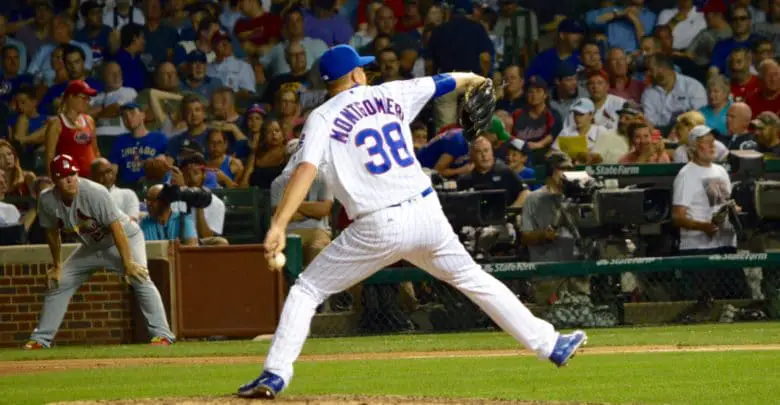
Balancing Mike Montgomery’s Innings and Pitches Is Playing Not to Lose
With the Cubs up 1-0 in the 6th inning and Mike Montgomery having driven in one more run than he’d allowed, Joe Maddon strode from the dugout and took the ball from the lefty. Montgomery hadn’t been what you’d call sharp and he had just walked Eric Hosmer. Plus the next batter, former Cub Christian Villanueva, has crushed lefties to the tune of a 1.068 OPS, so there’s that.
But there was already one out in the inning and Montgomery had retired Villanueva in two previous at-bats. What’s more, Maddon had just left his southpaw in there to bat for himself in the bottom of the previous inning. Outcome bias in that particular case might tell us it was the right call, since Monty actually ended up driving in a run.
The reality of the situation is that it took an El Mago slide from Willson Contreras to beat the tag at the plate and avoid what would have been an inning-ending double play. Absent that move, Montgomery doesn’t even pick up his team’s lone RBI. When it’s all said and done, though, the idea of leaving Montgomery in to hit is not, in and of itself, the only issue.
The crux of the situation is that the starter, who was working for the first time since the Cubs opted to keep him in the rotation over Tyler Chatwood, was only at 79 pitches. That’s tied for the fewest pitches he’s thrown since his first two starts, at which time he wasn’t yet fully stretched out. What’s more, Montgomery had only thrown nine pitches in the 6th inning, not exactly a number to set off alarm bells.
That Jesse Chavez ended up allowing a single to Villanueva is really irrelevant, since the hitter reached out and blooped a fastball up and away that shattered his bat like glass. Pumping a two-seamer to Austin Hedges — who I swear is this year’s Kirk Nieuwenhuis — stung quite a bit, but it’s the outcome bias talking again if you believe unequivocally that Monty would have retired Hedges after two previous singles.
What I’m driving at is that it’s not so much a matter of Maddon pulling Montgomery as it is the fact that he did it so early in the frame and after having let the pitcher bat for himself. Which brings us back to something I had written in the linked piece above in which I theorized that the Cubs might have a path to keeping Chatwood as a starter.
The crux of my theory lie not so much in the Cubs’ faith in Chatwood as it did their lack of desire to push Montgomery to the precipice of his effectiveness yet again. They saw — and he later vocalized — how moving back and forth between the ‘pen and the rotation, all the while racking up career highs of 130.2 innings and 2,075 pitches, had worn him down by season’s end.
What the Cubs are trying to avoid is doing the same thing again this season as Montgomery hurtles headlong on a trajectory to once again set high-water marks. Therein lies the problem here, since Maddon and the front office are trying to balance Montgomery’s usage against the unknown timelines for Yu Darvish and/or Drew Smyly. Both could be back by September, but neither can be counted on at this point.
Were Montgomery to remain in the rotation, he could get as many as 10 more starts this season. At his current starting-pitching averages of 5.2 innings and 86 pitches, he’d end up with 149 innings and 2,304 pitches. Those represent respective increases of 14 and 11 percent over last season, both of which seem modest but could still prove to be very significant.
Looking at Montgomery’s results, which are more about the inability to miss bats than they are his ERA, the Cubs can’t feel great about what he’ll be able to given them if he hits those usage marks. And that’s why Maddon had the short leash, though other factors could and should come into play. For instance, it’s unlikely that Montgomery will indeed rack up 10 more starts even if Darvish remains out all season because the Cubs will certainly employ a sixth starter at least once in September, thus pushing everyone back.
But in order for Montgomery to avoid any overages, he’s really going to make only five more starts at most before a move back to the ‘pen. At that point, you’re looking at his last start coming near the end of August and putting him around 122 innings and 1,844 pitches with a full month of relief work to go. With roster expansion and potential returns from injury, Montgomery’s innings could be more easily limited from then on.
What the Cubs are left with at this point is essentially using a prevent defense with Montgomery. They’re playing not to lose instead of playing to win, and that’s never a fun strategy manage. Without assurances that they’ll get reinforcements, they can’t burn Monty out. But if they don’t get those guys back and they need to keep starting him, they run the risk of overuse and ineffectiveness.
Damned if it’s six, damned if it’s half a dozen.
I don’t want this to read as a defense of Joe Maddon, because that’s not what it was meant to be in any way. Rather, my goal was to look at this particular matter through a wide-angle lens instead of a magnifying glass. Is that even a good analogy? My point is that there are so many different factors influencing these things that to fixate on a single game is perhaps not the most productive exercise.
At the same time, it’s still worth asking why in the hell you’d let the guy bat if conservation efforts were in place and he was only going to pitch to two more batters.

